How to grow Ensete
Grown for its spectacular, large, paddle-shaped leaves this extremely fast-growing, banana-like plant originates from tropics of Africa and Asia. Though resembling a tree, it is in fact a very large, evergreen perennial. This tender plant is unable to withstand frost and so will need to be moved indoors if it is to survive an average UK winter.
Though there are around 7 species of ensete, Ensete ventricosum (Abyssinian banana) is the one commonly cultivated throughout the UK. Of this, the AGM awarded red cultivar ‘Maurelii’ is most widely available; its huge, jungle-like leaves tinted red, with red mid ribs and dark red stalks.
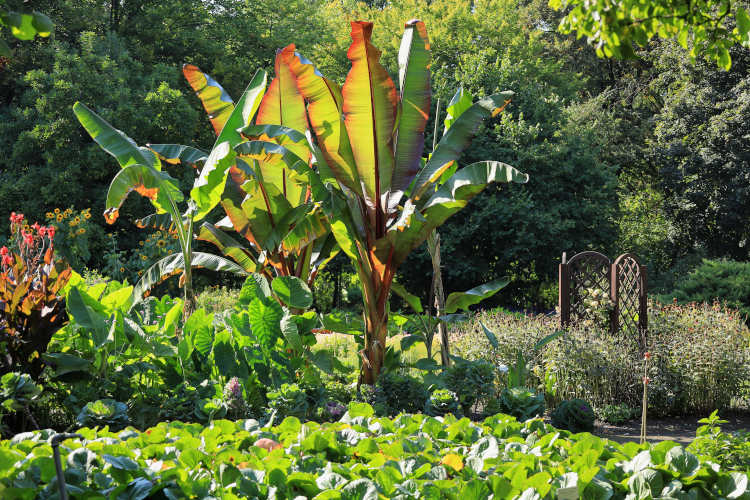
Zantedeschia is a genus of flowering plants from the family Araceae and is native to southern Africa. With a rich history dating back to the Ancient Romans, these deciduous or semi-evergreen perennials have been used as a symbol of celebration. Zantedeschia was Named after Professor Giovanni Zantedeschia, an Italian botanist.
There are two main forms of Zantedeschia: hardy and tender. Hardy forms of the plant can be grown outdoors, enjoy moist soil and full sun or partially shaded conditions - these are known as Arum lilies. Tender forms of Zantedeschia prefer being grown in containers or pots and should be brought inside over the winter - these are known as Calla lilies.
With tuberous flora in all colours from whites, yellows and oranges to deep reds and purples, Zantedeschias are not to be overlooked in any garden, as long as they have sufficient sunlight to grow in.
Ready to learn more about growing Zantedeschia? Read on for all there is to know...

Key Information
Soil pH
Position
Hardiness

Position- A warm, sunny spot with shelter from winds.
Ensure there is plenty of space for the leaves to extend – these plants have been known to reach 5m across.
Soil- Fertile, moist, well-drained. Avoid extremes of waterlogged or drought. Can be acid, alkaline, or neutral pH.
Flowering Period- Unlikely to flower (or fruit) outdoors in the UK. Specimens grown in a heated greenhouse or conservatory all year-round may flower in summer.
Hardiness- Tender/ H2/ 1°C to 5°C (needs winter protection)
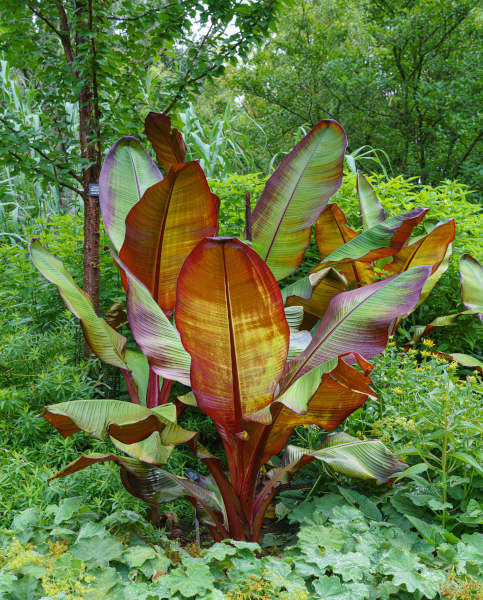
Where & when to plant Ensete
For best results, plant in late spring to early summer once all risk of frost has passed in your area. This varies from region to region, though for many tends to be around mid-May. Planting can also be carried out in summer, though be prepared to water regularly.
Ensete is a statement plant, perfect for adding height to exotic borders, contemporary courtyards, container displays, or conservatories. With its bold, vibrant foliage it is invaluable for anyone attempting to create a lush, jungle effect. Throughout most of the UK, ensete should be grown either as a container plant or else in the ground and lifted each autumn, the aim in both cases to enable indoor overwintering. Those lucky enough to have a very mild microclimate (a part of the garden that reliably remains above freezing, perhaps due to geographical factors or the insulating effects of a wall or building) may have success leaving ensete outdoors all year round. In these instances, however, excessive winter rainfall can be an issue, so do what you can to reduce this (ensure good drainage when planting, give the roots a thick, dry, winter mulch, plant in the rain shadow of a wall/ large tree etc.)
How to plant Ensete
Before moving your ensete outside, it is important you gradually acclimatise it – known as ‘hardening off’. We recommend taking the following steps:
WEEK 1 – wrap in two layers of fleece and place outside during the day only (moving to a warm, protected environment at night).
WEEK 2 – as WEEK 1, though this time with the fleece reduced to one layer.
START OF WEEK 3 – now with no fleece. If nighttime temperatures are reliably remaining above 1°C, you can leave outside at nighttime too, though reapply the fleece for this.
END OF WEEK 3 – leave outside completely uncovered for a couple of days/ nights before planting out as follows.
- For planting in the garden, dig the soil area removing any large stones and weeds and breaking up any lumps. Mix in some organic matter such as manure or garden compost. If your soil is on the heavier side, now is also the time to add a generous helping of horticultural grit. Rake level and firm with your heels. Rake level again.
- Water plants well and allow to drain before planting.
- A good tip is to dig a hole twice the size of the root-ball. Fill with water and allow to drain before placing in the plant.
- Place the plant in the hole, ensuring the top of the root ball sits level with the surface of the soil. Too low and the plant may rot, too high and the roots can dry out.
- Backfill with soil and firm in gently with your foot.
- Soak well with water.
- Mulch around the base with well-rotted organic matter.
- For planting in containers, first choose an appropriately sized pot (i.e., 5-10 cm larger than the rootball) ensuring there are plenty of drainage holes in the bottom.
- If you are using a large or heavy pot, it can be a good idea to fill and plant it in situ to save yourself the trouble of moving once full.
- Use a good quality potting compost with plenty of horticultural grit mixed in, and, if not already present in the compost (check the description on the bag) some slow-release fertiliser granules.
- Start by partially filling the pot with compost; enough so that when placed on it the upper surface of the root ball is about 3cm lower than the top of the pot.
- Infill all the space surrounding the root ball with compost, firming down with your fingers then adding a little more so the plant is held tight.
- Pick up the container and lightly tap on the potting bench or ground a few times to help further settle the compost around the plant.
- Soak well with water.
- A mulch with horticultural grit will look attractive and help to prevent a ‘cap’ or crust forming on the top of the compost (something container plants can suffer due to the artificial nature of their watering).
- Aim to repot into a larger pot every couple of years, going up approximately 10cm in size each time.
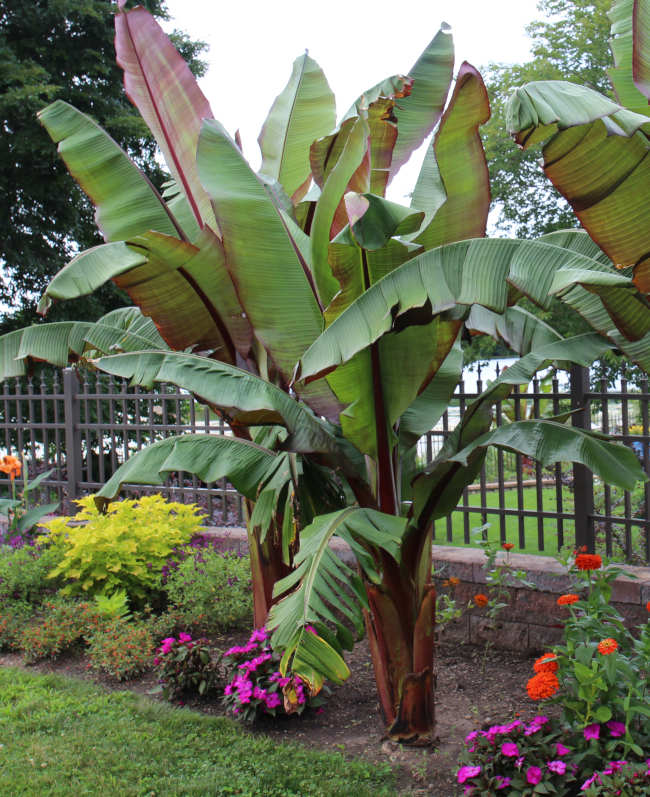
What to plant with Ensete
To achieve the lush, jungle-look, combine ensete with a dense mix of bold foliage plants such as trachycarpus, musa, chamaerops, fatsia, phormium. Add bright, jewel-like flowers like kniphofia, gladiolus, dahlia, canna, and agapanthus for colour interest.
Alternatively, if you’re planning to grow your ensete as a permanent conservatory plant consider colourful, indoor companions such as such as strelizia, dipladenia, citrus and plumbago.
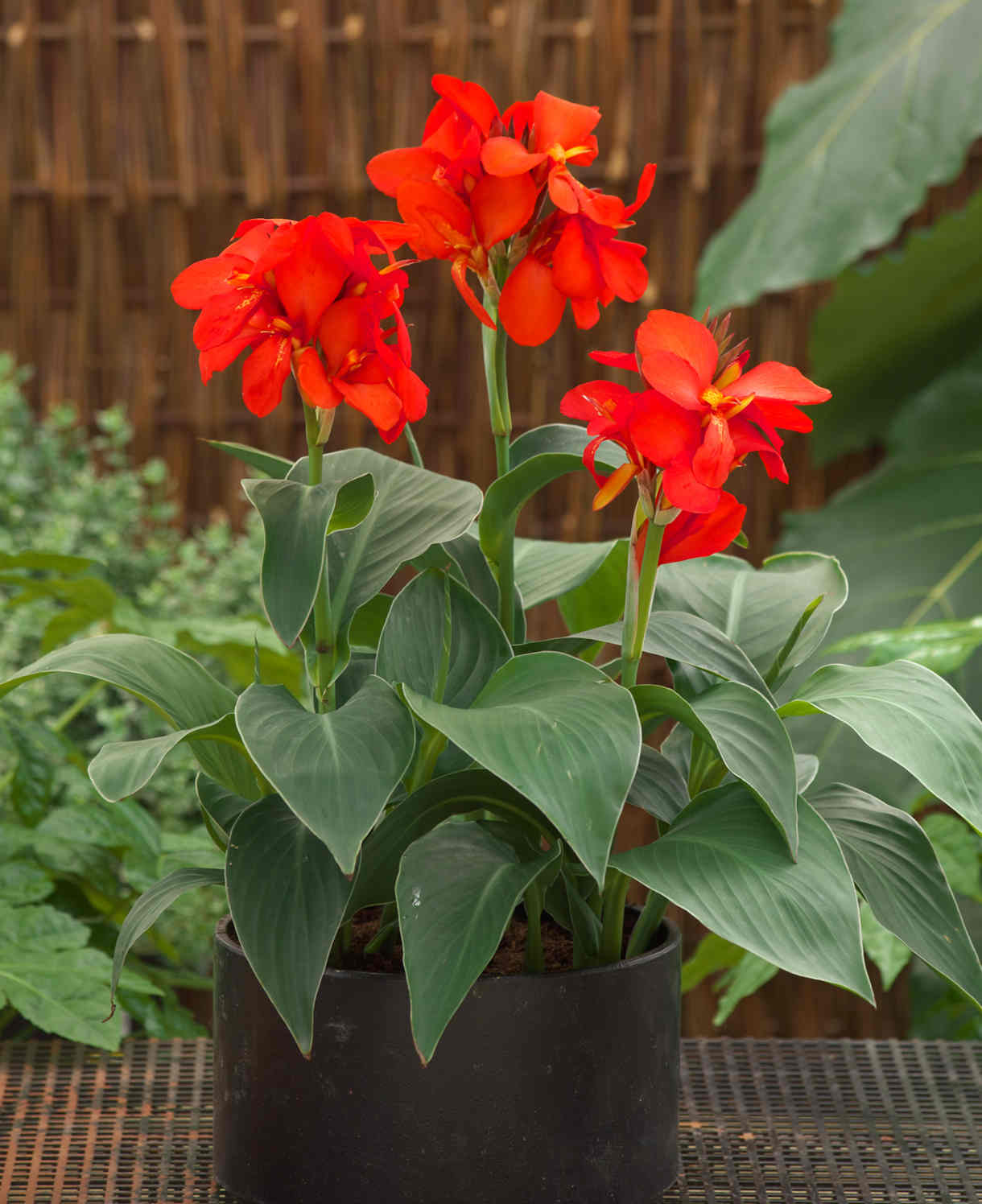
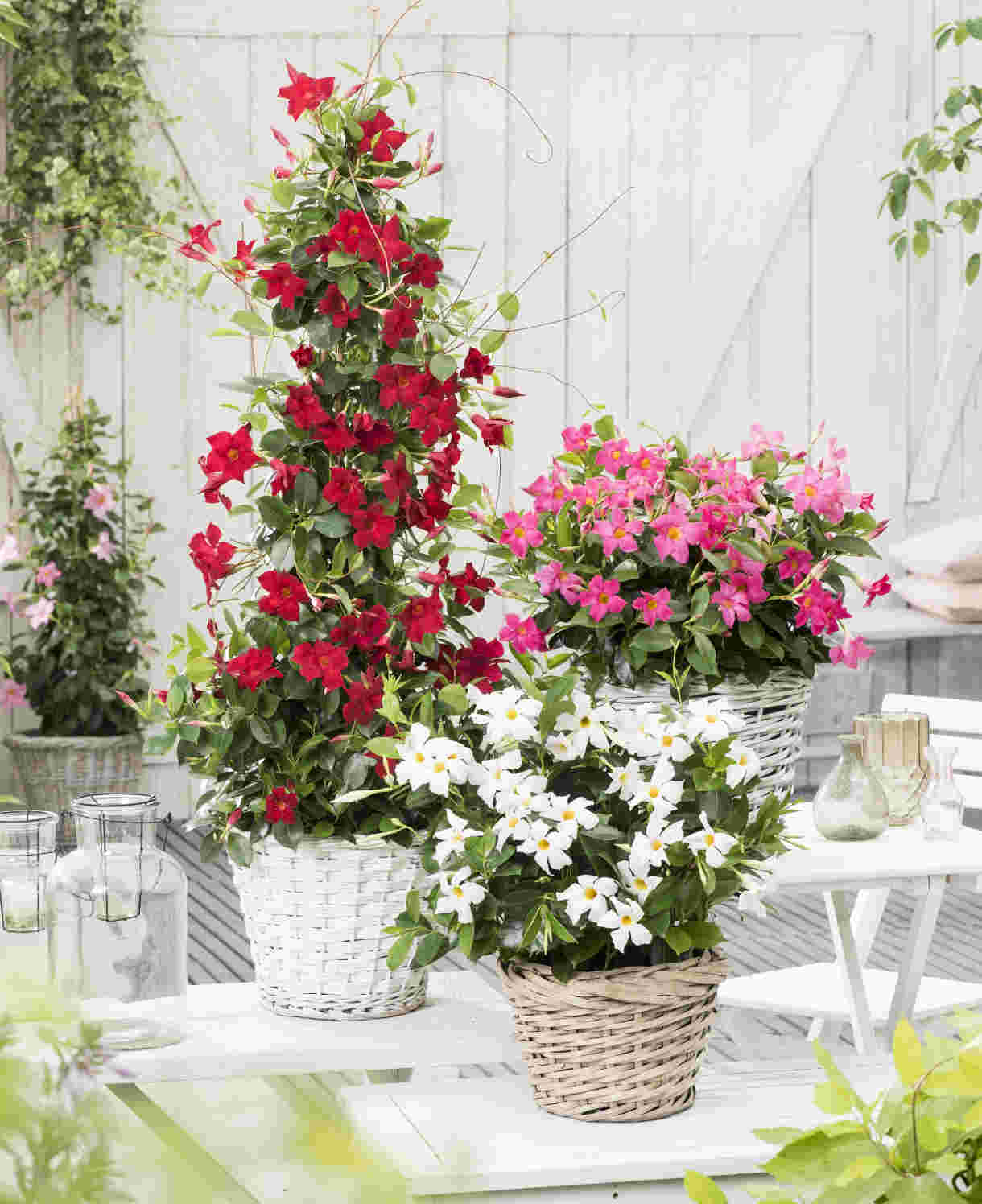
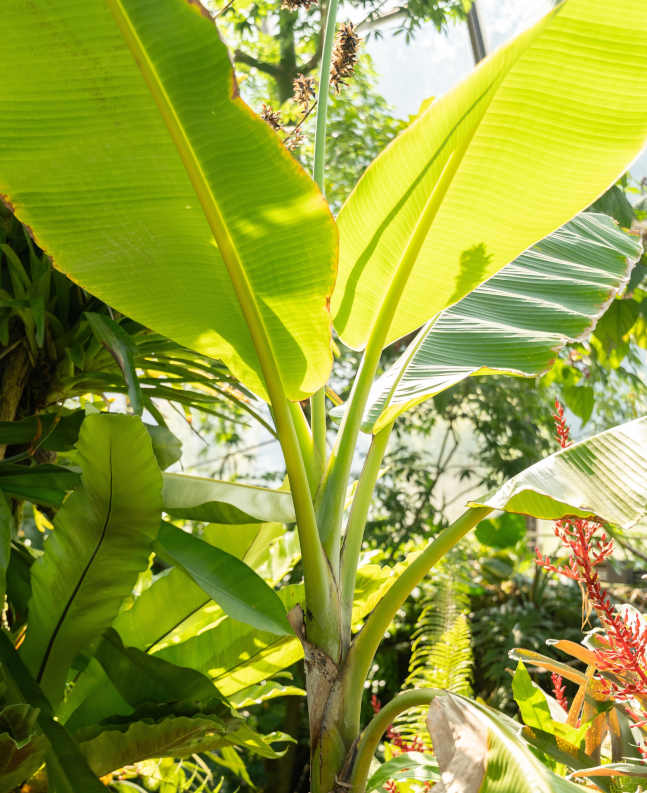
How to care for Ensete
Pruning and Deadheading
Cut off old leaves when they start to become tatty, snipping at the base of the leaf stalk.
If your ensete has grown too tall for the space it will respond well to a drastic chop carried out at any time during the growing season, as long as you leave a ‘stump’ of at least 60cm. While this may look severe, you should see leaves sprouting from the cut fairly quickly.
Cutting off all the leaves of your ensete in early autumn is an option, simply so it takes up less space when moved to its protected, indoor environment for winter. If space isn’t an issue, leave the foliage intact.
Watering
Ensete in the open ground needs to be watered generously throughout spring and summer. As a rule of thumb, aim for a good soaking every couple of weeks, increasing the frequency in hot, dry weather. Container-grown ensete needs even more attention as its roots have less access to rainfall. Allow the top few centimetres of compost to dry out between soakings (test this with your finger).
During winter, ensete that has been moved inside should be watered very sparingly, allowing the compost to almost entirely dry out between.
Feeding
It takes plenty of nutrients to power the impressive, rapid growth ensete is known for. On healthy, fertile soil, a spring application of general purpose granular feed covered with a mulch of well-rotted organic matter (i.e., a layer of manure or garden compost applied to the soil around the plant) should suffice. The mulch has the added benefit of suppressing weeds and locking in moisture.
If, however, yours looks in need of an extra boost (perhaps you garden on particularly poor soil), applying a weekly liquid feed to the roots throughout spring and summer can work wonders.
Container-grown plants rely more on the gardener for their nutritional needs. Get off to a flying start by making sure you use a good quality compost, then throughout the growing season (March to September) apply a weekly liquid feed, mixed according to its instructions.
Cold Protection
Ensete needs protection from the frost to survive winter. Either grow in a container or lift and pot each year (October is the best time for this), so you can overwinter it in a warm, sheltered environment. A heated greenhouse or conservatory are both ideal. The leaves can be removed is space is an issue (see ‘Pruning and Deadheading’ section).
If you don’t have a heated greenhouse or conservatory, you may wish to consider the slightly hardier alternative Musa basjoo, which can survive a winter outside with fleece protection.
Pests and Diseases
Outdoors, ensete tends to be problem-free, though in glasshouses or conservatories the usual issues of spider mite and aphid can crop up. Keeping plants as healthy as possible is the key to warding off problems, and by this we mean proper ventilation, adequately spaced plants (for good air flow), keeping everything well-watered and fed, and repotting into larger containers when necessary. Thoroughly cleaning the indoor environment every winter can also help to remove overwintering populations of pests.
Where infestations do take hold, try introducing biological controls (often sachets or tubes containing miniscule natural predators), or in the worst cases, remove the affected plant/s altogether.
How to propagate Ensete
Unlike Musa basjoo, ensete doesn’t produce suckers and can therefore only be propagated by seed. Unfortunately, as fruits are rarely produced in the UK, this means home propagation is not usually an option. Instead, buy new, small plants or order seed online.
Common Ensete Questions
- How fast does ensete grow?
This is a very fast-growing plant and will often reach full size in four to five years. - When should I lift ensete?
Aim to get this done in October, or even earlier if frosts are expected to hit your local area before then.




